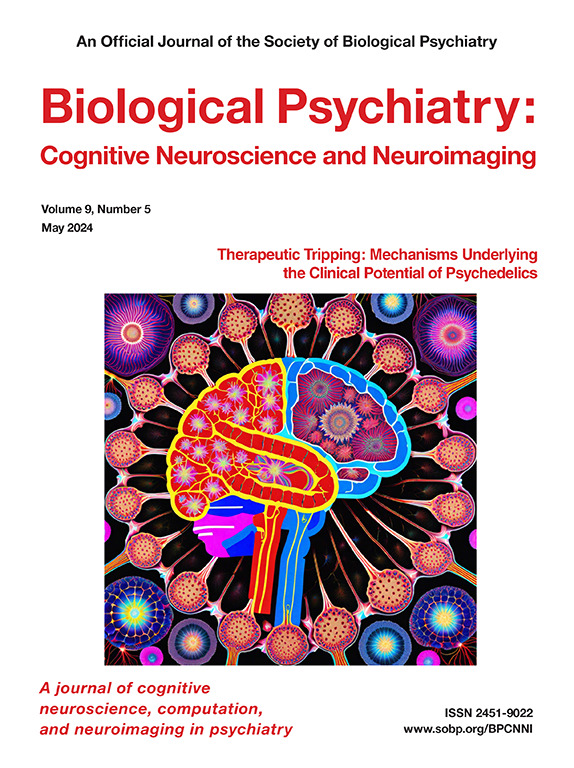解码强迫症:区域脆弱性指数及其与临床症状的关系。
IF 4.8
2区 医学
Q1 NEUROSCIENCES
Biological Psychiatry-Cognitive Neuroscience and Neuroimaging
Pub Date : 2025-08-01
DOI:10.1016/j.bpsc.2025.01.013
引用次数: 0
摘要
背景:强迫症(OCD)患者表现出显著的大脑结构改变,这可能与临床相关。最近,在精神分裂症中,引入了区域脆弱性指数(RVI)来将增强神经成像遗传学荟萃分析(ENIGMA)研究的结果转化为个体水平。在这个框架的基础上,本研究试图调查RVI是否也可以作为强迫症的脆弱性指数。方法:为此,我们评估了250名参与者(140名强迫症患者,110名健康志愿者)的皮质下体积和皮质厚度,并利用enigma衍生的缺陷作为预期大脑区域改变的“基本事实”,计算了RVI。结果:与健康对照组相比,患者皮质下体积和皮质厚度RVI值有显著差异。此外,基于皮质下体积的RVI值与临床症状的严重程度显著相关。此外,皮质下体积和皮质厚度的RVI值在用药亚组中均有显著差异,而在未用药的患者中无显著差异。结论:目前的结果表明,RVI可能代表了个体特征,反映了个体结构改变模式与疾病特征结构改变模式之间的对应程度。然而,我们的研究结果也表明,在荟萃分析的“基本事实”中,相对较大的效应量是获得有意义的RVI参数的先决条件,该参数也与临床严重程度有关。因此,目前的研究结果需要通过进一步的研究来确认RVI的稳健性并确定其预测价值。本文章由计算机程序翻译,如有差异,请以英文原文为准。
Decoding Obsessive-Compulsive Disorder: The Regional Vulnerability Index and Its Association With Clinical Symptoms
Background
Patients with obsessive-compulsive disorder (OCD) exhibit notable alterations in brain structure, which are likely to be of clinical relevance. Recently, in schizophrenia, the regional vulnerability index (RVI) was introduced to translate findings from ENIGMA (Enhancing Neuro Imaging Genetics through Meta Analysis) studies to the individual level. Building on this framework, in the current study, we sought to investigate whether the RVI might also serve as a vulnerability index for OCD.
Methods
Toward this aim, we assessed subcortical volume and cortical thickness in a sample of 250 participants (140 patients with OCD, 110 healthy volunteers) and calculated the RVI by leveraging ENIGMA-derived deficits as the “ground truth” for expected regional brain alterations.
Results
Subcortical volume and cortical thickness RVI values were significantly different in patients compared with healthy control participants. In addition, RVI values based on subcortical volume were significantly correlated with the severity of clinical symptoms. Moreover, RVI values for both subcortical volume and cortical thickness were significantly different in medicated subgroups while there was no significant difference in unmedicated patients.
Conclusions
The current results suggest that the RVI may represent an individual characteristic that reflects the degree of correspondence between individual patterns of structural alterations and disease-characteristic patterns of structural alterations. However, our findings also indicate that relatively large effect sizes in the meta-analytic ground truth are a prerequisite for obtaining a meaningful RVI parameter that can also be related to clinical severity. Therefore, the current findings require further validation through additional research to confirm the RVI’s robustness and determine its predictive value.
求助全文
通过发布文献求助,成功后即可免费获取论文全文。
去求助
来源期刊

Biological Psychiatry-Cognitive Neuroscience and Neuroimaging
Neuroscience-Biological Psychiatry
CiteScore
10.40
自引率
1.70%
发文量
247
审稿时长
30 days
期刊介绍:
Biological Psychiatry: Cognitive Neuroscience and Neuroimaging is an official journal of the Society for Biological Psychiatry, whose purpose is to promote excellence in scientific research and education in fields that investigate the nature, causes, mechanisms, and treatments of disorders of thought, emotion, or behavior. In accord with this mission, this peer-reviewed, rapid-publication, international journal focuses on studies using the tools and constructs of cognitive neuroscience, including the full range of non-invasive neuroimaging and human extra- and intracranial physiological recording methodologies. It publishes both basic and clinical studies, including those that incorporate genetic data, pharmacological challenges, and computational modeling approaches. The journal publishes novel results of original research which represent an important new lead or significant impact on the field. Reviews and commentaries that focus on topics of current research and interest are also encouraged.
 求助内容:
求助内容: 应助结果提醒方式:
应助结果提醒方式:


